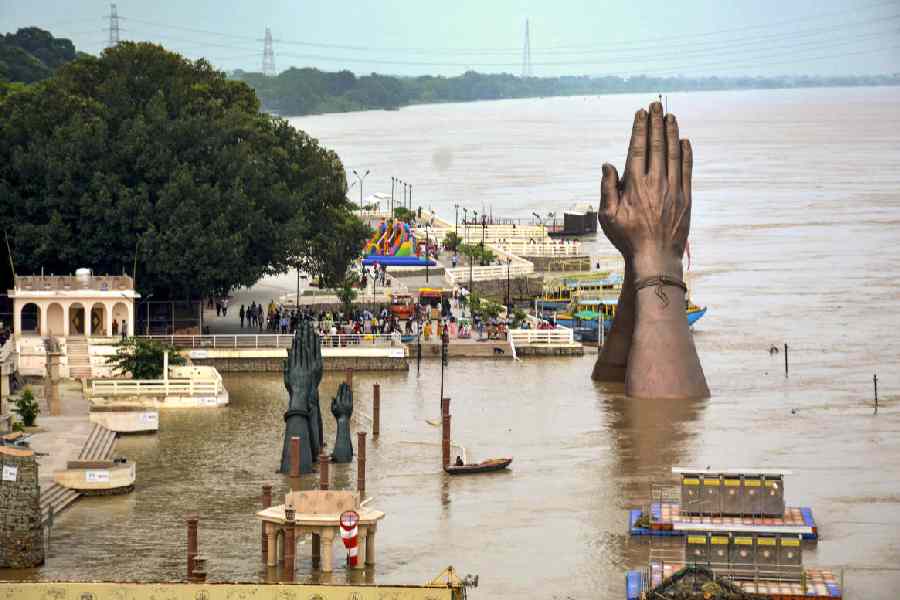Kanpur: The Ganga River, often revered as the lifeline of India, has turned into a force of devastation as severe floods sweep across Northern India. Triggered by relentless monsoon rains and upstream water releases, the deluge has wreaked havoc in Uttar Pradesh, Bihar, and West Bengal. Entire villages stand submerged, cultural practices have been disrupted, and thousands of families have been forced to flee their homes. Authorities are racing against time to deliver relief in what is now being called one of the worst floods in recent memory.
Rising Waters Across Cities
In Varanasi, the Ganga breached its danger mark of 71.26 meters and rose to 71.66 meters on August 4, engulfing all 84 ghats, including the sacred Dashashwamedh and Manikarnika. Low-lying settlements like Salarpur and Pulkohna are underwater, affecting 32 villages and 24 localities. In Prayagraj, both the Ganga and Yamuna rivers crossed the danger level of 84.73 meters, flooding more than 200 villages and 60 urban neighborhoods. The revered Bade Hanuman Mandir has been inundated, bringing religious rituals to a standstill. Ballia too has been hit hard, with the river climbing to 58.12 meters and submerging homes and farmland. Bihar is reeling under the impact as well, with more than 1,000 villages submerged, particularly in Patna and in districts along the Kosi River.
The Causes Behind the Crisis
The crisis has been driven by a combination of natural and human-induced factors. Uttar Pradesh recorded 14.2 mm of rainfall on August 3, with 24 districts hit by intense showers. Torrential rains in Uttarakhand added to the flow, worsening the downstream situation. The opening of 18 gates at Matatila Dam and 8 gates at Govind Sagar Dam released massive amounts of water into the Ganga, further compounding the problem. Experts point to heavy silt accumulation that has raised the riverbed, making it more prone to flooding. Climate change has also intensified monsoon cycles, while the Farakka Barrage in West Bengal has caused backflow into Bihar, amplifying the scale of the disaster.

Human and Economic Toll
The floods have uprooted thousands of families, with more than 2,000 people evacuated from Varanasi alone. Crops across thousands of hectares in Uttar Pradesh and Bihar have been destroyed, threatening food security and farmers’ livelihoods. Roads, bridges, and railway tracks have been damaged, leaving communities cut off from essential services. Beyond the economic impact lies a cultural wound, as sacred sites such as Varanasi’s ghats and the Sangam in Prayagraj remain inaccessible. The suspension of rituals has left local communities grappling with both spiritual and financial loss.
“The water came so fast, we barely had time to save anything. Our crops are gone, and we don’t know how we’ll recover,” said Rakesh Kumar, a resident of Salarpur in Varanasi. In Prayagraj, priest Sanjay Pandey added with anguish, “The Bade Hanuman Mandir is flooded, and devotees cannot come. This is both a spiritual and economic blow for us.”

Relief Efforts Underway
The Uttar Pradesh government has mounted large-scale operations to deal with the unfolding crisis. Thirty flood posts have been activated, with National Disaster Response Force and State Disaster Response Force teams deployed in affected districts. Chief Minister Yogi Adityanath is personally monitoring the situation. More than 1,500 people are currently housed in temporary relief camps in Varanasi and Prayagraj, where food, water, and medical supplies are being distributed. Flood alerts remain active in 13 districts, including Mirzapur, Ghazipur, and Jalaun, as officials urge residents in low-lying areas to evacuate.
Spotlight on Systemic Weaknesses
Experts warn that the Ganga floods highlight systemic weaknesses that must be addressed to avoid repeated crises. Effective silt management through dredging and better riverbed monitoring is critical. Encroachment on floodplains and poor urban drainage in cities such as Varanasi have worsened the disaster, demanding urgent reforms in planning. With monsoon patterns becoming more erratic under climate change, investment in early warning systems, resilient infrastructure, and climate adaptation strategies is vital.
“The Ganga is our mother, but without proper management, she becomes a challenge we’re not equipped to handle,” noted Dr. Anjali Sharma, hydrologist at Banaras Hindu University.





